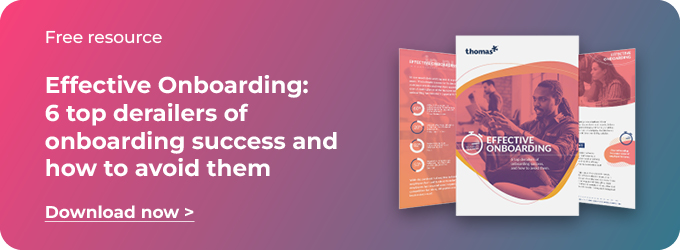Table of contents
Onboarding has become the new employee go-to for HR departments around the globe. Think of it like establishing a healthy relationship from the very beginning, you want everyone to feel comfortable, open to question and debate and importantly, valued for their work.
Well, onboarding is about creating the right workplace environment which allows you to do just that but also understand recruitment is an ongoing process, and requires more than just a nice welcome letter, a great first day or a first-week orientation program. It is a culture that needs to be built and one that gives every employee the possibility to thrive in their new role and in the company.
Creating that process is about optimizing the best ideas in HR and developing a system that works for your business and the new starter. From interview to the employees lifecycle in the business, building an optimal onboarding process is essential.
In this guide we will give you insight into what onboarding is, it’s importance, the different stages associated and best practice ideas on how to create an onboarding process in your business.
What is employee onboarding?
Onboarding is the integration process used to ensure a smooth transition for employees into their roles and into the organization. However, from one organization to another, this may vary as the role of onboarding could also be a new strategy for current employees to become more familiar with working practices or part of a wider organizational training as well.
Employee onboarding is more than just an introduction into the business, it has become a critical recognition of management to see what their new employee is also like and how they respond to the working environment and job role. Studies have shown that 4% of employees quit after their first day, 50% after their first four months and that 40% of managers hired externally fail within the first 18 months of their job.
It is the role of onboarding to help new employees feel welcome and prepared for their jobs and contribute to the organizational mission, culture and values. It is why onboarding is traditionally carried out in the first 2-3 weeks before a new employee starts and continues for the first 2-6 months of an employee starting.
Some organizations may choose to look at the onboarding process as a singular day job whilst others may take the timescales mentioned above. It is dependent, traditionally, on the size of the organization and the kind of work that is being carried out.

Importance of employee onboarding
Onboarding has been shown to have many benefits. Think of it from the perspective of a new starter joining a business. There will be emotion and nerves involved in starting in a new workplace, a new company culture to understand and how the role will pan out.
By creating an employee onboarding program, the benefits are designed to not only help quell these fears but to also develop the workforce to be more appreciative of other staff members as well creating solid relationships and work practices as a byproduct.
Here are just a few of the key benefits that employee onboarding brings:
- Establishes a positive employee experience from the start
As for the reasons described above, creating a positive experience for any new employee from the start is going to boost employee morale and help the new starter settle down quicker.
- Higher employee engagement
Being able to explain what you want from the employee in the first few days and as such, setting expectations will help the employee understand their role, and what it is they can do to add to the business. In return this helps foster goodwill and boost engagement.
- Easier talent attraction
It is also important to understand the onboarding process helps engage and promote your brand to potential employees. It’s then easier to get better, more skilled workers to your business if the talked about experience is better.
- Supports staff retention
Losing workers is an expensive cost that a business doesn’t want to develop. Organizations with a strong onboarding process improve new hire retention by 82%. That’s why it is important to start onboarding as soon as a new hire has signed the contract.
- Boosts productivity
Making someone feel welcome from the get-go is important for many different reasons, but what if that person knew precisely what was expected of them, who to report to, what their workload looked like and who they could lean on to get through the work? It would make their work better, and facilitates better working practices around the organization.
- Accelerates time to proficiency
One of the benefits of boosted productivity is that it will take less time for the new starter to get proficient at their job. There is less time spent training in some of the areas where onboarding can really help make a difference.
- Assimilates new staff into the company culture
Building a strong internal culture is important, that’s why any new starter needs to understand what the organizational culture looks like and if/how they fit into it. Onboarding helps starters understand the culture making them more comfortable and aware of how people behave, respond and deal with customers. Sharing information about the company’s mission, vision, and values early (and often) in the employee lifecycle helps build the momentum.
- Helps identify training needs
One of the most important things about a new employee relationship is to understand how much training they may need, or what training they require to help get through the day-to-day processes. Things such as understanding timesheets or even doing their job needs to be understood quickly. Onboarding helps set expectations but also helps evaluate skills development requirements and addresses them in a cogent manner to help develop the new starter.
Stages of employee onboarding
The employee onboarding process can effectively be broken down into a number of distinct stages which include, pre-boarding, first day, first week, first 90 days and finally, the first year.
This can help you identify the steps you need to take in order to create an onboarding procedure which is specific to each member of staff. Next, we break down the stages into each section so that you can develop your own unique onboarding process.
Pre-boarding
Pre-boarding takes place when the candidate is offered and accepts a position. There are usually several things a company can do at this stage to help the pre-boarding process run smoothly, including automating the onboarding process as quickly as possible.
- Employees should expect a welcome pack which includes things like a video reference, company information and their bespoke onboarding plan.
- A checklist for their first day. I.e. knowing where to go, who to report to, where they will be working, who they will be working with and even what to wear helps.
- Some like to do a video introduction to the team or even a face to face meeting in a social environment before the first day to get everyone acquainted with the new starter.

First day
The first day is arguably the most important day. Remember the statistic from earlier? 4% of new starters leave on their first day. So creating a good impression is essential, and one that is positive is even more important.
There are lots of things you can do to make the process simple, fun and positive. Some of the more practical things are the ones overlooked.
- Create a buddy system with a more experienced member of staff. They can help do introductions to the rest of the business, show where things are and help answer any questions.
- A talk with the I.T. team to help understand how to login, any procedures for taking out equipment, how to access the network and access to the internet if products need it.
- Going for lunch with the team so that it feels more comfortable for the new recruit is always a good idea.
First week
In the first week, any new recruit is going to have questions or even potential concerns, so it is important to listen, make them feel comfortable that they can discuss their concerns and issues and also build a trusting relationship with their manager and team. Some of the things that you can do in the onboarding process include:
- Have an informal chat with H.R. to address any issues, concerns or just to meet the new recruit.
- Involve senior management in this process as well. Make someone feel valued throughout the whole chain of command.
- Have social meetings with the new team member as well. Make it an event for their first week and help them get involved in the business.
- Sit down with the new employee to scope out what they need over the forthcoming months (90 days).
First 90 days
The first 90 days allows new employees to really get stuck into their new role and their employers to get a better impression of their talents. Having a clear understanding of how someone has been performing and how they are doing in the team is essential. Also, how they feel about the work and what their contribution has been is important to gauge from their perspective. Therefore, there are things that you can do to make sure that they are feeling comfortable, valued and challenged.
- Use a checklist to check what’s been achieved. I.e. are they hitting targets and if they have, reward them for it.
- Have a formal 90 day appraisal where there is feedback from the team.
- Set new goals for the next 90 days and schedule some informal chats as well.
First year
Although most of the onboarding process will have been completed within the first weeks and months, it is important to have a review after a year. It can be extremely beneficial to all parties involved but importantly, it needs to be understood that the new starter hasn’t been forgotten about either, leaving their ideas, contributions and work feel more valued.
An end of year onboarding review should identify any issues and also what have been the positives about working for the company so that it can be used to help identify future requirements and talent recognition.
Employee onboarding best practices
There are many things that you can do to make the onboarding process run smoothly or be a seamless experience for the new employee, however, it’s important to remember not to stress over it. Fundamentally there is not a 'one size fits all' approach, rather, it’s a 'size that best fits your business' vision that you need to build.
There are however some best practices which you can include in your onboarding process that can help you identify what it is you want the experience to be for both the employee and for your team.
A good starting place would be to talk to your team about their experience joining and develop some ideas together to make it better for your new starters with a new process underway.
Here are some of the other best practices we would recommend.
Start onboarding early
Onboarding should start from when a candidate receives or accepts a job offer.
It’s important to establish clear communication with the candidate/new employee from the get go. Making someone feel welcome when they have a decision to make, or are naturally nervous about change is key.
Make new employees welcome
Another important aspect of onboarding is that you need to make any new employees feel welcome. That’s about communication, setting expectations but also giving them time to get into the role and do the kinds of things that give a calm and relaxed atmosphere so that they can integrate quickly.
Making that employee count is critical. Giving them special attention and getting the team to rally round is important.
Involve senior management
It can be easy to assume that recruitment and the aftermath of recruitment should be solely down to the HR department but, it’s not. Key to onboarding is that the company supports the new employee, not just a department or person.
Senior management has a key role to play here. As previously mentioned, new employees are likely to feel more valued if they are acknowledged by senior management early on.
It also shows that the new starter is being valued by people who they may not deal with daily but will have to create or manage work which is their responsibility.

Establish regular one-to-one meetings
As previously mentioned, having consistent, one-to-one meetings is an important part of not only onboarding but general employee engagement and development. Understanding where there could be issues or opportunities is important but also, it gives your employees a sounding board which without any regular meetings would not be possible.
Regular meetings also help give importance to their roles and what they do. Making someone’s work valuable helps promote ownership of their work.
Connect with workmates
Being able to work independently and in teams is critical for anyone in the professional world. In onboarding, one of the keys to creating a successful integration of new team members is about bringing people together.
From social events which could be a day out together or even virtual drinks, getting to know one another and making the new employee feel like part of the team is important to establish early on.
Other social events can include:
- Bowling
- Go karting
- Paintballing
- Taking the team out for a meal
- Virtual quiz nights
Over time, bonds will form with some team members over others, but critically, in the onboarding process, you want that new employee to feel relaxed and comfortable around their teammates.
Use onboarding software
You can use onboarding software to help with the process from start to finish.
From taking assessments during the recruitment process - which can be used to provide insight throughout the employee lifecycle enabling you to keep your staff engaged and productive - to managing how to communicate with them and play to their strengths and build on their weaknesses, the Thomas talent assessment platform can be used throughout the employee lifecycle.
Bespoke employee onboarding with Thomas
The Thomas talent assessment platform provides a bespoke solution for your onboarding process. Far too often, businesses use a one-size-fits-all approach which can leave new starters feeling disengaged when they should be at their most motivated.
Each new starter needs to be treated as an individual. What’s the best way to communicate with them? How do they approach decisions? What really motivates them? Understanding whether or not your new employee responds well under stressful environments or is better suited to more logically challenging scenarios is key to getting the best out of them.
Delivered online, this technology is perfectly designed in a changing work landscape to support the onboarding of remote workers as well as in office staff.
In summary
Onboarding is a relatively new process which has major benefits to the employee as well as employer. By clearly giving your new employee all the tools at the beginning, making them feel valued and giving out what you expect from them, you are establishing a relationship which can be built upon over time. By helping them to integrate into the team quicker and get more acquainted with processes and culture, they can be more productive and give you valuable feedback and insights from regular meetings to help move the business forward.
There are many solid best practices that you can use to help you create a good onboarding experience but there are no cookie cutter approaches to employee onboarding. Software such as the Thomas talent assessment platform enables you to deliver bespoke onboarding tailored to the individual, getting them up to speed quicker and improve their long-term engagement.
To find out more, speak to one of our team.





